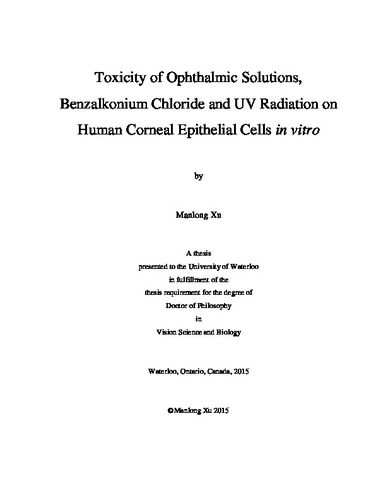| dc.contributor.author | Xu, Manlong | |
| dc.date.accessioned | 2015-06-12 12:33:20 (GMT) | |
| dc.date.available | 2015-06-17 05:30:29 (GMT) | |
| dc.date.issued | 2015-06-12 | |
| dc.date.submitted | 2015 | |
| dc.identifier.uri | http://hdl.handle.net/10012/9426 | |
| dc.description.abstract | The purpose of this work was to develop a sensitive in vitro method for ocular toxicity testing; and to use this method to assess the individual and combined effects of ophthalmic solutions, benzalkonium chloride (BAK), and ultraviolet (UV) radiation on the eye; as well as to investigate the detoxification of BAK in vitro.
Using an in vitro test battery with immortalized human corneal epithelial cells (HCEC) and fluorescent dyes, the toxicity of differently preserved ophthalmic solutions was assessed in the first chapter of the thesis. The BAK-preserved solutions demonstrated the greatest adverse effect on HCEC, followed by the solutions with other preservatives. The preservative-free ophthalmic solution had the least adverse effect. The in vitro test battery demonstrated high sensitivity and good correlation with in vivo and clinical studies.
PrestoBlue is a new resazurin-based reagent for assessing cell metabolic activity and cytotoxicity. The second chapter compared PrestoBlue, alamarBlue, and 3-[4,5-dimethylthiazol-2-yl]-2,5-diphenyltetrazonium bromide (MTT) in assessing cell viability of HCEC. The result showed that PrestoBlue was more sensitive than MTT, but similar to alamarBlue. The plate color, reading mode and plate storage up to 7 days did not affect the performance of the PrestoBlue assay.
Using the in vitro test battery with the new reagent PrestoBlue, the third chapter assessed the individual and combined toxicity of UV radiation (UV A and UVB) and BAK on HCEC. The combined effects of UV plus BAK were either greater than (synergistic) or equal to (additive) the sum of individual effects. The synergistic effects occurred between a low dose UV radiation (0.1719 J/cm²) and low concentrations (0.001%, 0.002%, 0.003% and 0.004%) of BAK.
The last chapter investigated the detoxification of BAK by UVC radiation. The result showed that BAK toxicity on HCEC can be neutralized by an appropriate dose of UVC radiation. After complete neutralization, the toxicity of BAK was similar to phosphate buffered saline. While, the antimicrobial effect of BAK against Pseudomonas aeruginosa was reduced at the same time.
The results of this work suggest that BAK-free, especially preservative-free ophthalmic solutions are safer alternatives to BAK-preserved ones. The combined toxic effects of BAK and solar radiation should be taken into consideration in the risk assessment of BAK-preserved ophthalmic solutions. UVC radiation can be used to neutralize BAK toxicity. This detoxification may be of great value in utilizing the antimicrobial efficacy of BAK while minimizing its potential hazards. The in vitro test battery with cultured HCEC used for this research may provide a sensitive and meaningful approach for evaluating both individual and combined ocular toxicity of UV radiation and chemicals. | en |
| dc.language.iso | en | en |
| dc.publisher | University of Waterloo | en |
| dc.subject | in vitro | en |
| dc.subject | ophthalmic solution | en |
| dc.subject | benzalkonium chloride | en |
| dc.subject | ultraviolet radiation | en |
| dc.subject | human corneal epithelial cells | en |
| dc.subject | cell viability | en |
| dc.subject | alamarBlue | en |
| dc.subject | PrestoBlue | en |
| dc.subject | MTT | en |
| dc.subject | Toxicity | en |
| dc.subject | tight junction | en |
| dc.subject | confocal microscopy | en |
| dc.subject | fluorescent viability dyes | en |
| dc.subject | synergistic effect | en |
| dc.subject | additive effect | en |
| dc.subject | neutralization | en |
| dc.subject | ZO-1 | en |
| dc.subject | antimicrobial efficacy | en |
| dc.title | Toxicity of Ophthalmic Solutions, Benzalkonium Chloride and UV Radiation on Human Corneal Epithelial Cells in vitro | en |
| dc.type | Doctoral Thesis | en |
| dc.pending | false | |
| dc.subject.program | Vision Science and Biology | en |
| uws-etd.degree.department | School of Optometry and Vision Science | en |
| uws-etd.degree | Doctor of Philosophy | en |
| uws.typeOfResource | Text | en |
| uws.peerReviewStatus | Unreviewed | en |
| uws.scholarLevel | Graduate | en |

